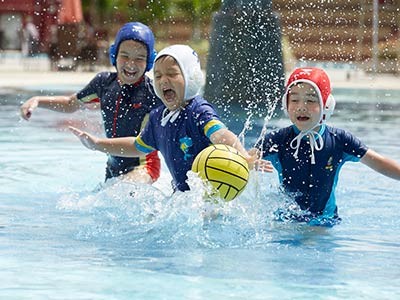What on Earth is Flippa Ball?

Flippa ball gives children (and beginners of all ages) a taste of water polo in a fun and simple format—laying the foundation for future competitive ambitions.
Now, let's be frank, with the glowing track record that Singapore’s water polo teams have, it can be tempting to start your children early to help uncover and develop their potential for the aquatic sport that's a mix of grace, raw strength, gritty tenacity and quick-thinking strategy—it’s great to aim high but here’s why you should begin with flippa ball.
Early sport specialisation’s drawbacks
Yes, getting your children involved in structured and competitive sports at an early age has many benefits, it also can be a source of unnecessary stress and inflated expectations that weigh them down and lead to burnout.
The solution to this conundrum of introducing children to sports without putting undue pressure on them may lie in the beginner-friendly and mini versions of specific sports. Is your child interested in water polo? Check out flippa ball!
Flippa ball makes water polo more accessible
Water polo is a sport that regularly earns medal glory for Singapore on the international stage, and yet it is a sport that has a relatively small pool of players, recreational and competitive alike. Equipment, pool space, knowledge of the game and swimming ability raise the barrier to entry, and this is where flippa ball can bridge the gap.
What is flippa ball?
Think of flippa ball as the lite version of that new shiny electronic gadget—it looks and feels similar but is much more accessible and friendlier. Flippa ball introduces primary school children to water polo, but you'll find people of all ages playing the game too because of its casual nature. From swim schools to water polo clubs, flippa ball programmes are available worldwide, and you'll be happy to know that it's also part of the roster of programmes at select ActiveSG swimming pools.
Why is flippa ball better than water polo for children?
Played in a shallow pool and being able to have feet on the bottom of the pool (when not in possession of the ball), flippa ball adds a layer of safety because it doesn't push players to their physical limits (i.e., constantly treading water with the eggbeater kick), and this gives players (children) more energy to focus on swimming with the ball, passing, shooting (ball skills) and most importantly, working as a team.
The relaxed nature of flippa ball also makes it ideal for helping children grasp the tactical and strategic concepts of water polo progressively and find joy in the sport—which are a lot harder to appreciate if they’re gasping for air and feeling the (muscular) burn. Then if and when they’re ready to transition to water polo, you can help support them as they take their next step with the skills and knowledge they've gained from flippa ball.
Here’s a brief rundown of how flippa ball is played.
The pool of play
- A shallow pool (1.2–1.3m deep).- Seven players per team (one goalkeeper and six field players—or up to 10 players).
Playing the game
- Players can catch the ball with two hands but only pass or shoot with one hand.- Players can walk along the bottom of the pool except when they have the ball.
- Players may not submerge the ball when they have possession.
- There is no tackling in flippa ball (a non-contact sport).
What are flippa ball's prerequisites?
For safety reasons, we recommend players know how to swim and be confident in the water. Do check out this article on the benefits of swimming for children.
With the recent $100 credit top-up for ActiveSG members aged 4–12, starting 1 May 2023, it's the perfect time to explore flippa ball programmes at the nearest ActiveSG pool!





![ActiveSG Academies and Clubs Logo (Solid Colour)[8647]](https://www.activesgcircle.gov.sg/hs-fs/hubfs/ActiveSG%20Circle%202023Theme/images/ActiveSG%20Academies%20and%20Clubs%20Logo%20(Solid%20Colour)%5B8647%5D.png?width=150&height=65&name=ActiveSG%20Academies%20and%20Clubs%20Logo%20(Solid%20Colour)%5B8647%5D.png)




-01.png?width=200&height=141&name=Team%20Singapore%20Logo%20(Red)-01.png)










